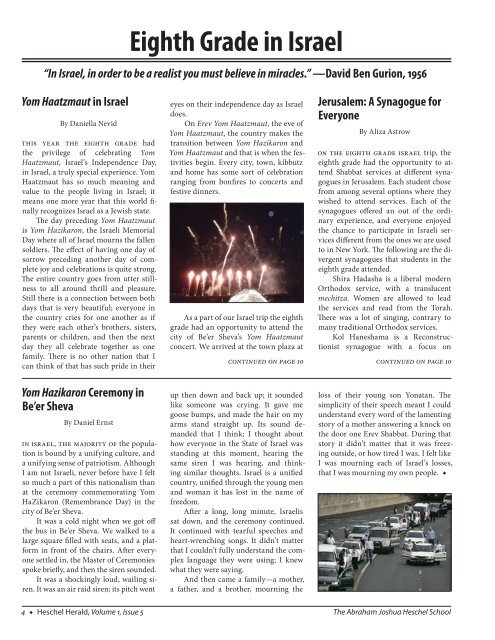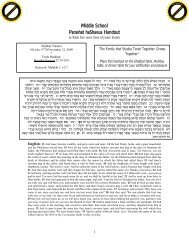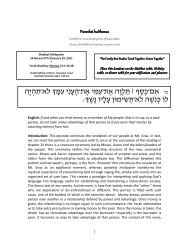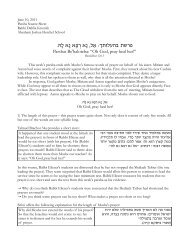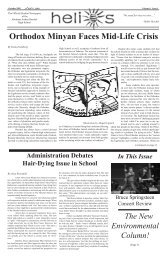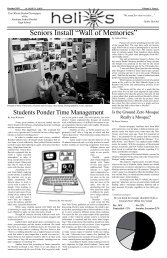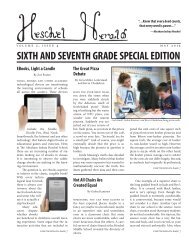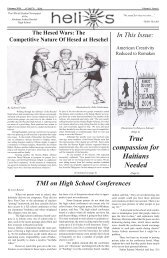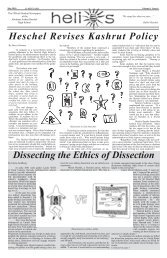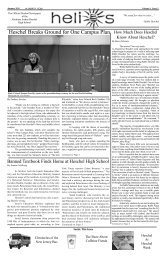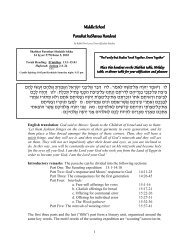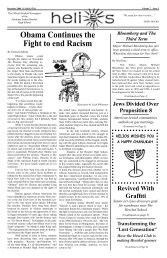Volume 1, Issue 5 (June 2011) - The Heschel School
Volume 1, Issue 5 (June 2011) - The Heschel School
Volume 1, Issue 5 (June 2011) - The Heschel School
Create successful ePaper yourself
Turn your PDF publications into a flip-book with our unique Google optimized e-Paper software.
Eighth Grade in Israel<br />
“In Israel, in order to be a realist you must believe in miracles.” —David Ben Gurion, 1956<br />
Yom Haatzmaut in Israel<br />
By Daniella Nevid<br />
This year the eighth grade had<br />
the privilege of celebrating Yom<br />
Haatzmaut, Israel’s Independence Day,<br />
in Israel, a truly special experience. Yom<br />
Haatzmaut has so much meaning and<br />
value to the people living in Israel; it<br />
means one more year that this world finally<br />
recognizes Israel as a Jewish state.<br />
<strong>The</strong> day preceding Yom Haatzmaut<br />
is Yom Hazikaron, the Israeli Memorial<br />
Day where all of Israel mourns the fallen<br />
soldiers. <strong>The</strong> effect of having one day of<br />
sorrow preceding another day of complete<br />
joy and celebrations is quite strong.<br />
<strong>The</strong> entire country goes from utter stillness<br />
to all around thrill and pleasure.<br />
Still there is a connection between both<br />
days that is very beautiful; everyone in<br />
the country cries for one another as if<br />
they were each other’s brothers, sisters,<br />
parents or children, and then the next<br />
day they all celebrate together as one<br />
family. <strong>The</strong>re is no other nation that I<br />
can think of that has such pride in their<br />
Yom Hazikaron Ceremony in<br />
Be’er Sheva<br />
By Daniel Ernst<br />
In Israel, the majority of the population<br />
is bound by a unifying culture, and<br />
a unifying sense of patriotism. Although<br />
I am not Israeli, never before have I felt<br />
so much a part of this nationalism than<br />
at the ceremony commemorating Yom<br />
HaZikaron (Remembrance Day) in the<br />
city of Be’er Sheva.<br />
It was a cold night when we got off<br />
the bus in Be’er Sheva. We walked to a<br />
large square filled with seats, and a platform<br />
in front of the chairs. After everyone<br />
settled in, the Master of Ceremonies<br />
spoke briefly, and then the siren sounded.<br />
It was a shockingly loud, wailing siren.<br />
It was an air raid siren; its pitch went<br />
eyes on their independence day as Israel<br />
does.<br />
On Erev Yom Haatzmaut, the eve of<br />
Yom Haatzmaut, the country makes the<br />
transition between Yom Hazikaron and<br />
Yom Haatzmaut and that is when the festivities<br />
begin. Every city, town, kibbutz<br />
and home has some sort of celebration<br />
ranging from bonfires to concerts and<br />
festive dinners.<br />
As a part of our Israel trip the eighth<br />
grade had an opportunity to attend the<br />
city of Be’er Sheva’s Yom Haatzmaut<br />
concert. We arrived at the town plaza at<br />
Continued on page 10<br />
up then down and back up; it sounded<br />
like someone was crying. It gave me<br />
goose bumps, and made the hair on my<br />
arms stand straight up. Its sound demanded<br />
that I think; I thought about<br />
how everyone in the State of Israel was<br />
standing at this moment, hearing the<br />
same siren I was hearing, and thinking<br />
similar thoughts. Israel is a unified<br />
country, unified through the young men<br />
and woman it has lost in the name of<br />
freedom.<br />
After a long, long minute, Israelis<br />
sat down, and the ceremony continued.<br />
It continued with tearful speeches and<br />
heart-wrenching songs. It didn’t matter<br />
that I couldn’t fully understand the complex<br />
language they were using; I knew<br />
what they were saying.<br />
And then came a family—a mother,<br />
a father, and a brother, mourning the<br />
Jerusalem: A Synagogue for<br />
Everyone<br />
By Aliza Astrow<br />
On the eighth grade Israel trip, the<br />
eighth grade had the opportunity to attend<br />
Shabbat services at different synagogues<br />
in Jerusalem. Each student chose<br />
from among several options where they<br />
wished to attend services. Each of the<br />
synagogues offered an out of the ordinary<br />
experience, and everyone enjoyed<br />
the chance to participate in Israeli services<br />
different from the ones we are used<br />
to in New York. <strong>The</strong> following are the divergent<br />
synagogues that students in the<br />
eighth grade attended.<br />
Shira Hadasha is a liberal modern<br />
Orthodox service, with a translucent<br />
mechitza. Women are allowed to lead<br />
the services and read from the Torah.<br />
<strong>The</strong>re was a lot of singing, contrary to<br />
many traditional Orthodox services.<br />
Kol Haneshama is a Reconstructionist<br />
synagogue with a focus on<br />
Continued on page 10<br />
loss of their young son Yonatan. <strong>The</strong><br />
simplicity of their speech meant I could<br />
understand every word of the lamenting<br />
story of a mother answering a knock on<br />
the door one Erev Shabbat. During that<br />
story it didn’t matter that it was freezing<br />
outside, or how tired I was. I felt like<br />
I was mourning each of Israel’s losses,<br />
that I was mourning my own people. ◆<br />
4 ◆ <strong>Heschel</strong> Herald, <strong>Volume</strong> 1, <strong>Issue</strong> 5 <strong>The</strong> Abraham Joshua <strong>Heschel</strong> <strong>School</strong>


